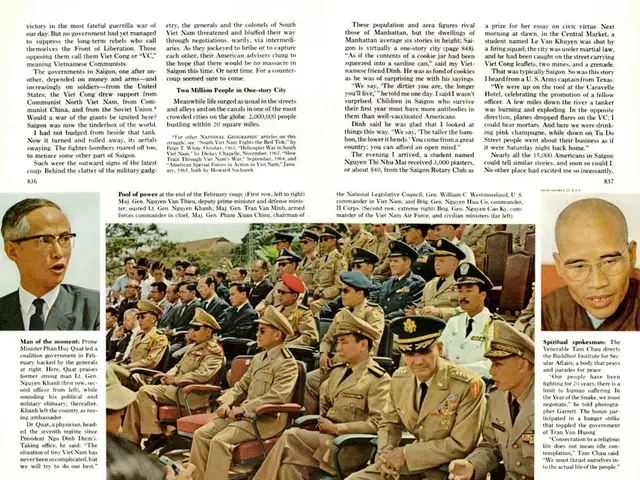Unleashing the Power of Leadership: A Fresh Perspective
Developing Effective Leadership: Crucial Competencies and Tactics
Leadership, my man, it's the badass ability to guide, influence, and fire up people or groups to reach common goals. This ain't some highfalutin' fancy shit reserved for those with fancy titles, nah, it's all about stepping up and taking charge. And when we're talking about organizations, communities, and even our daily interactions, lead's where it's at, homeslick.
The role of an effective leader is enormous, especially in organizations, where motivation and productivity are essential. Leaders who know their shit are vital in setting a vision, strategizing, and steering their squad towards objectives. Building an environment that encourages innovation, accountability, and top-notch performance is all part of the lead's job, and when people feel valuable and understood, they step their game up, leading to greater productivity and organizational success.
In community contexts, leadership has its place, too. Community leaders link folks with resources and opportunities, providing a spark for collective action and promoting inclusivity. Leading in a community connects the dots, bringing people together and enhancing cohesion.
Let's dive into the traits a successful lead should possess:
- Emotional intelligence: It's about feeling emotions and understanding the emotions of others, navigating tricky social situations, making strong connections, and handling conflicts like a pro.
- Decisiveness: A badass who makes informed decisions swiftly and with confidence is a must-have. This is crucial, especially when shit hits the fan, as hesitation can lead to missed opportunities or worsening situations.
- Integrity: Dishonesty is a no-go. A true leader earns respect and loyalty by being honest, transparent, and upstanding. Demonstrating integrity fosters an atmosphere of trust, where people feel valued and safe.
- Confidence: Swagger is vital for inspiring people and rallying the troops. It helps support initiatives, encourages calculated risks, and, most importantly, radiates a conviction that we can achieve our goals.
Leadership Styles: Getting the Job Done
The art of leading ain't one-size-fits-all, my friend. Throughout history, various leadership styles have evolved, and understanding them can improve your managing game. Here are some key styles:
- Transformational leadership: This approach inspires and motivates followers to embrace a shared vision, fostering innovation and change. Leaders like Nelson Mandela are prime examples of this style.
- Transactional leadership: All about order and structure, this style focuses on tasks, roles, rewards, and punishments based on performance. Manufacturing industries often favor this style due to its efficiency.
- Servant leadership: Empowering team members is crucial in this style. Focusing on their needs drives a supportive and collaborative work environment. Mahatma Gandhi's leadership style falls under this category.
- Autocratic leadership: Go-getters who make decisions alone are vital during crises since quick, decisive actions are needed. Military contexts often feature autocratic leaders.
By grasping these styles, you'll gain insight into your preferred leadership approach and adapt when necessary based on your team and situation.
Effective Communication: The Lead's Secret Weapon
Communication is crucial in effective leadership, my G. Mastering the art of conveying ideas clearly and persuasively is key to influencing team dynamics and organizational performance. Some leading communication strategies include:
- Active listening: It's more than just hearing the words; it's about really understanding the underlying feelings and intentions. When people feel heard and understood, they feel valued, and trust emerges, leading to better teamwork.
- Non-verbal communication: Body language, facial expressions, and tone speak volumes. Positive vibes can inspire people and motivate them, while negative signals can create roadblocks and misunderstandings. Stay mindful of your non-verbal cues and ensure they align with your verbal messaging.
- Open dialogue: Encouraging team members to share their thoughts and ideas fuels creativity and innovation. Regular check-ins and feedback sessions foster a culture of transparency and inclusivity, leading to increased morale and productivity.
Building High-Performing Teams: Unleashing the Power of Collaboration
Gathering and leading top-notch teams is essential for any organization aiming for success. Core team dynamics, characterized by trust, collaboration, motivation, and open dialogue, play a significant role in building these teams.
- Trust and collaboration: Fostering an atmosphere of trust and openness empowers people to take risks and share innovative solutions, enhancing the team's capacity to face challenges. Collaboration leads to improved efficiency and effectiveness.
- Motivation: Releasing your inner cheerleader can boost morale and drive performance. Offering constructive feedback, recognizing achievements, and setting challenging yet achievable goals can all serve as effective motivation boosters.
- Conflict resolution: Resolving conflicts quickly and fairly is vital to maintaining a positive atmosphere. By addressing issues head-on, you prevent their escalation, ensuring ongoing team harmony.
Setting Goals and Objectives: Achieving Your Vision
Effective leadership demands a clear vision, and that vision comes to life through well-defined and actionable goals and objectives. The acronym SMART (Specific, Measurable, Achievable, Relevant, and Time-bound) provides a helpful framework for setting meaningful goals.
- Specific: These goals make it crystal clear what needs to be accomplished, ensuring everyone understands exactly what's expected of them.
- Measurable: By quantifying outcomes, you can easily track progress and stay aligned with your objectives.
- Achievable: Ensure your goals are realistic and attainable. Striving for unrealistic objectives demotivates people.
- Relevant: Goals should support your broader organizational mission and vision, keeping everyone focused and on track.
- Time-bound: Setting deadlines creates a sense of urgency and accountability, keeping your team dialed-in and focused.
The Role of Feedback and Performance Management: Nurturing Growth
Feedback is crucial in effective leadership, helping you guide your team towards success. Leaders should provide three types of feedback: positive, negative, and developmental.
- Positive feedback: Encourages team members by highlighting their strengths, reinforces desirable behaviors, and improves morale.
- Negative feedback: When delivered constructively, this feedback addresses areas of improvement, minimizes defensiveness, and aids in addressing performance issues.
- Developmental feedback: Offers guidance on how to grow, helps people develop their skills, and aligns individual goals with broader organizational objectives.
Effective performance management involves setting expectations, assessing progress, and adjusting strategies as needed. Regular feedback sessions create a culture of continuous learning and improvement.
Navigating Contemporary Challenges in Leadership: Staying Ahead of the Game
Modern leaders face numerous challenges, such as:
- Adapting to remote work environments: With teams distributed across diverse locations, leaders must leverage technology to promote an inclusive, connected, and engaged workforce.
- Fostering employee engagement and retention: Leaders need to create captivating work environments that attract, motivate, and retain top talent.
- Navigating operational volatility: Facing global disruptions requires leaders to sharpen forecasting, supply chain performance, and talent management skills.
- Integrating technology and AI: Incorporating AI and analytics into daily operations can boost efficiency, predict market shifts, and unlock opportunities.
- Managing stress and building resilience: Leaders are the linchpins keeping teams united amidst turbulent times, requiring emotional intelligence, adaptability, and swift decision-making skills.
By staying nimble, adaptable, and innovative, leaders can weather the storm and lead their organizations to success despite the ever-evolving organizational landscape.
- Effective leaders are instrumental in fostering a business environment that encourages productivity, as they set a vision, strategize, and guide their teams towards objectives.
- In the global marketplace, innovation is key to staying ahead, and leaders must embrace technology and inspire their teams to drive change and create new products.
- To develop a profitable career, personal growth, education, and self-development are essential components, as they empower individuals to lead successfully in various business contexts.
- leadership skills are not limited to the professional sphere, as they also play a crucial role in nurturing healthy personal relationships based on trust, openness, and effective communication.
- In today's interconnected world, communication through a blog or other digital platforms can be an effective means to share insights, engage audiences, and establish oneself as an industry thought leader in the realm of business, finance, and leadership.
- As the landscape of business continues to evolve, with increasing emphasis on diversity, sustainability, and social responsibility, innovative leaders will focus on creating positive relationships with stakeholders, fostering an inclusive work environment, and prioritizing financial and social returns to achieve long-term success.








